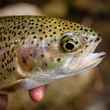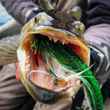When we planned the trip, some eight months out, we had anticipated our timing to be near perfect. If things went as they should, we’d be hitting the water during the ideal week, just as springtime mayfly hatches really started to kick off — rousing the trout from their lingering winter lethargy, sending them in chase of the sort of bounty they hadn’t seen in more than half a year. We’d spend the week casting delicate dry flies to eager browns and rainbows on the region’s spring creeks and lake-fed freestoners. And so we filled our boxes with all the requisite patterns, tossed old spools of 6x in favor of fresh ones, and grabbed presentation-friendly rods in favor of all-purpose ones. But, as fishermen are supremely aware, things rarely go as planned.
Though we arrived to sunny skies, balmy winds and verdant green hills, the weeks prior had been dominated by unseasonably cold weather and relentless, pounding rains. And so, spring was late. Days that were supposed to be spent honing our reach casts and perfecting delicate presentations were instead spent slinging sinking lines and other heavy rigs on rain-swollen creeks and whitecap-crested rivers. Several days in, the Thomas & Thomas Paradigm, which I’d laid hands on specifically for this trip, hadn’t come out of my rod case.
The new, “21st Century” Paradigm is Thomas & Thomas’ reinvention of one of the most heralded rods in its history. The original Paradigm, built over 20 years ago, is one of those rods beloved by dry fly purists who will glaze over entire rooms full of eyes reminiscing about the good ol’ days before fast-actions rods became the coin-of-the-realm—the days of rods like Winston’s IM6, Sage’s LL and ZXL, G. Loomis’ Streamdance and the T&T Paradigm.
On day four, however, the Paradigm made the list of gear that was slated for the boat, with eyes on finally giving it a chance to do some work. The day’s float would take us by a steady series of backchannels—which, though tepid and often stagnant by summertime, would be fed and fueled by high springtime waters—where we hoped we’d find trout behaving as they would be in the main channel had springtime’s arrival not been delayed.
What Works
Craftsmanship / Build Quality
Fly anglers are notorious for being an aesthetically-driven bunch, often to a fault. We’ve all heard about fly patterns that are designed more to catch fisherman than fish, and this same concept, though not to function-sacrificing consequence, is applied to fly rods and reels and all manner of other tools of the trade. A product whose appearance produces a visceral reaction in its owner (or prospective owners) tends to end up in more hands.
There is, of course, nothing inherently wrong with this—even if fly anglers can be superficial dandies from time to time. After all, a tool whose design and craftsmanship produces a sense of appreciation in the mind of its owner is a tool that brings more joy to its owner’s labor. And, if you haven’t figured it out by now, finding joy in the labor of fishing is what fly anglers are all in search of. We certainly don’t cast fly rods and flies because they catch more fish.
For the Paradigm’s part, it’s hard to imagine finer design and craftsmanship in a rod. This comes as little surprise, given that fine craftsmanship is a hallmark of virtually every Thomas & Thomas creation. The Paradigm is a beautiful, deep blue color, trimmed with lighter blue wraps and silver accents and is adorned with T&T’s signature handwritten script. The rod is finished with titanium single foot REC guides, superb quality cork and a beautiful Bird’s Eye burled maple spacer.
Beached at the head of the float’s first backchannel, the Paradigm is a rod that added joy to my labor the moment I took it out of its sock—and I don’t feel the least bit bad about that.
Weight
In a world of fly rods where the limits of lightweight rods are constantly being pushed (although not all that much, these days), the Paradigm is noticeably light and nimble in the hand. Other than small, impossibly frail, pre-pubescent anglers—it’s difficult to conceive of anyone needing a rod to be lighter.
Action
While I was still stringing up the Paradigm, my boatmates had already spotted three separate pods of trout feeding in the backchannel. The first in a quick riffle at the head of the channel and the other two down below in a wide, slow, nearly glass-still slick. I was dispatched to work the lower, considerably more difficult groups of fish while my more experienced fishing companion was inexplicably offered the plucky fish in the riffle.
Having spent the entire trip casting a stiff 7 weight, I was ready for comedy to unfold when dropping three rod weights and transitioning to the Paradigm’s advertised medium, more “classic” action and being immediately tasked with delivering a precise, delicate presentation to fish that were likely to be put down or sent fleeing by anything less.
This is likely a good time to mention that anglers, and especially marketers, will use a large variety of not-particularly-clear language to describe the action of a fly rod—the way that rod bends and flexes. This is primarily because describing the way a fly rod behaves is deeply subjective and hard to accomplish, but can also be because the individual doing the describing is ill-equipped for the task or just generally full-of-shit. And so all descriptions of the action of fly rods should be taken with an enormous grain of salt. The answer to whether a fly rod is right for you—or for your application—lies in casting it.
That said, sincere descriptions of a fly rod’s action can be useful for understanding whether that rod is a candidate for your quiver. If a rod geared for dry fly aficionados is what you’re in the market for, you’re looking for a rod with a medium or slow action, one which bends deep into the butt section of the rod, and has a supple but sensitive tip.
The Paradigm, unsurprisingly, ticks all these boxes. Unlike many slower action rods, however, the Paradigm offers a considerable level or responsiveness. Even after three days of casting a fast-action, much heavier rod, transitioning to casting the Paradigm felt surprisingly natural. Despite flexing deep into the blank, the rod rebounded confidently but gracefully, allowing me to easily produce tight loops whether working the fish nearer to me at about 25 feet or those hugging the far bank at over 50 feet.
Perhaps most importantly—as a caster that’s prone to overpowering the end of his cast—the Paradigm’s soft tip allowed me to deliver flies delicately without any deliberate effort on my part. That soft tip also proved masterful at tippet protection when, after a few well-placed practice runs, my first “real” cast with the Paradigm produced a fish (something we all know never happens). And not just any fish, but the largest fish of the group (another thing we all know never happens) and the only one of any real size, a stout, energetic 18” rainbow finning amongst a group of otherwise young-of-the-year dinks .
Feel
If you’ve read any of my rod reviews in the past, you’re likely aware that I regularly poke fun at marketing speak and both qualitative and quantitative measurements of rod performance. Not because those things don’t matter or mean anything, but because they’re too heavily factored or featured. Swing weight matters. And power. As does torsional stability (I mean, that sounds important, doesn’t it?) Crispness, too. Deflection charts? Why not?
But none of these matter on their own. A rod with epicly low swing weight that otherwise casts like dog shit is, well, dog shit. But when you consider all these wonky terms and subjective evaluations together, they combine to give a rod its feel — or at least as far as I’m concerned they do. And how a rod feels translates directly into how much of a pleasure it is to cast.
To be fair, feel doesn’t matter for all rods. Or, at least not as much. I don’t care much about whether a musky rod pricks the hairs on the back of my neck with the grace of its casting stroke. And a tight line nymphing rod? Get serious. But when presentation is key, feel becomes paramount.
In fact, there may be no endeavor I undertake with a fly rod where feel is more important than casting dry flies to wary trout. In these situations I want the rod to disappear from my mind entirely, and for casting to become as intuitive as possible. If I have to concentrate on not overpowering my cast, or how to maintain the right tempo when I need to lengthen my stroke, or how to add just the right amount of power to deliver a reasonable reach cast without overshooting my mark—then I’m going to fail more often that not. I need these things to happen without me having to think about them all that much. Feel is what makes this sort of thing possible.
For my dry fly fishing, the Thomas & Thomas Paradigm is more well suited to the pursuit than any rod I’ve cast in recent memory. It feels, if you will, tuned to the needs of the dry fly angler. Or at least this dry fly angler. Paired with the right line, there’s an inherent harmony to casting a dry fly with the Paradigm—one that lets me concentrate on the objective of my cast rather than the mechanics of it.
And that last point might be the most instructive or important, specifically because I’m not a particularly accomplished dry fly angler. The casts that make for success when pursuing rising trout—reach casts, curve casts, puddle casts and so on—don’t come effortlessly for me. If I’m left worrying about what the rod is doing, the rest goes to hell. When the rod disappears, and I can focus on the cast iself, I’m a great deal more likely to turn out something resembling my intent.
What Doesn’t
Versatility
It’s almost pointless to address versatility when discussing specialty rods, because being versatile is something they’re specifically designed to not be. It goes without saying that a rod named “The Destroyer” or “Balls” isn’t for chasing tiny creek trout underneath a tight canopy. Likewise, delicate dry fly rods aren’t for flipping triple nymph rigs comprised of marble-sized stoneflies or for casting flies made of mattress foam to greedy pike.
The Paradigm is not an all-purpose tool. It’s primarily for casting dry flies to rising trout. This is what you should use it for.
That’s not to say it’s entirely unsuited to more varied pursuits. In fact, the following day when we moved to a spring-influenced creek that flows through exposed pastureland, given how hard the wind was blowing, it might have been best to stow the Paradigm—especially given the big hoppers and chubbies we were casting and aggressively twitching, trying to lure big brown trout out from under the juvenile willows that lined its banks. But the rod got the job done, albeit with a considerable amount of extra effort involved at times.
Distance
Along these same lines, it should be obvious that the dry fly rods are not distance-casting tools. Can you throw casts over 70’ with the Paradigm? Sure. Can you do it with deadly accuracy? I’m sure some folks can. I can’t. But it’s not made for that. So why would you expect to?
FInal Word
It seems fair to say that Thomas & Thomas has done the original, iconic Paradigm a solid. That they’ve leveraged 21st century technological advancements in graphite, resin matrices, and components to build a modern version of its classic without betraying the beating heart of its original. That’s no small feat, especially in a world where the industry’s vision of what makes a “proper” dry fly rod has changed so dramatically over the years.
The Thomas & Thomas Paradigm is a rod that’s unquestionably built for dry fly anglers, but with a level of responsiveness that won’t require you to retool your entire cast in order to take advantage of its virtues. Its classic, medium action, intuitive feel and stunning craftsmanship will bring joy to the labor of casting dry flies to trout—even if that’s not much of a labor at all. And, it just might make you better at it, too.
































Comments